So, what goes on during a health inspection?
Good question. When conducting an inspection at any retail food facility the goal remains the same, protect public health. This theme directs everything that is done during the inspection process. We have three priorities that we address during an inspection. They are:
- Immediate Health Hazards
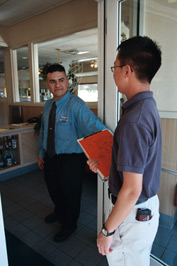
- Top 5 Risk Factors for Foodborne Illness
- General sanitation and maintenance
All of our inspections are unannounced, meaning that the food facility operator receives no prior notification that we are coming. That being said, we don't barge into a restaurant kitchen and start digging. When we get to a facility, we introduce ourselves and explain why we are there. We then invite the owner, manager, or whoever is in charge to join us during the course of the inspection. Then we head for the back of the house.
The inspection begins with a quick survey of the facility. The purpose of this cursory inspection is two-fold. First, it allows us to get familiar with the facility and operations before beginning an in depth evaluation. Second, it gives us an opportunity to spot right away any major violations that may be occurring in the facility such as a sewage system back-up or potentially hazardous foods left sitting out at room temperature.
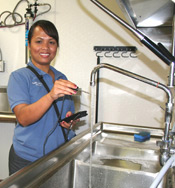 The first thing that an inspector will do is wash their hands and their thermocouple (a fancy thermometer) prior to touching any equipment or taking any temperatures. We hold not only our food facility operators to the highest food safety and sanitation standards, but we hold ourselves to them as well.
The first thing that an inspector will do is wash their hands and their thermocouple (a fancy thermometer) prior to touching any equipment or taking any temperatures. We hold not only our food facility operators to the highest food safety and sanitation standards, but we hold ourselves to them as well.
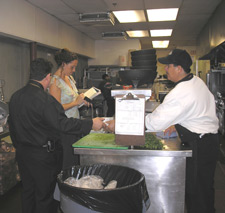 The first part of the kitchen that we head for is where all the action is. The cook's line and prep stations are the places where there can be the greatest threat to the safety of the food. We spend time observing food preparation practices, taking food temperatures, and making sure that food preparation equipment and utensils are clean and sanitary.
The first part of the kitchen that we head for is where all the action is. The cook's line and prep stations are the places where there can be the greatest threat to the safety of the food. We spend time observing food preparation practices, taking food temperatures, and making sure that food preparation equipment and utensils are clean and sanitary.
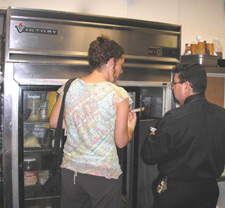 Once that is complete, we shift towards any walk-in coolers, freezers, or other food storage areas. We are checking to make sure that food is properly stored and free of contamination. Food temperatures are checked again to make sure that refrigeration is working properly.
Once that is complete, we shift towards any walk-in coolers, freezers, or other food storage areas. We are checking to make sure that food is properly stored and free of contamination. Food temperatures are checked again to make sure that refrigeration is working properly.
We then move on to the utensil and equipment washing areas. This is where dirty utensils and equipment are washed, rinsed, and sanitized. This is usually done in either a 3-compartment sink or a mechanical dish machine. Here we are making sure that the 3-step process is done correctly, and that the proper water temp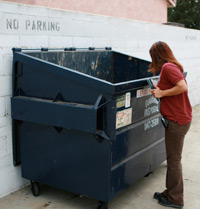 erature and sanitizer concentrations are being maintained.
erature and sanitizer concentrations are being maintained.
The inspection is wrapped up with a survey of the remaining ancillary areas of the facility like the janitorial area, restrooms, employee change room, outside the facility including the garbage area. These areas are checked to make sure that they are being maintained in a clean and sanitary state. These areas are also inspected to make sure that there is no food, utensils, or other food preparation equipment stored there.
During each of these inspection steps we are constantly vigilant for any signs of cockroach or rodent activity. We are making sure that everything is kept clean and in a sanitary condition. We also keep a watchful eye out for any equipment that is broken, utensils that may be deteriorating, and structural maintenance issues that may contribute to a problem down the road.
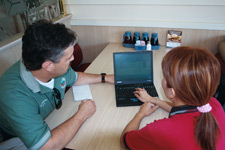 Once the inspection is complete, the inspector prints up a copy of the food facility inspection report for the operator. The inspector reviews the report with the operator to make sure that everything in the report is clear, as well to answer any questions or offer any suggestions.
Once the inspection is complete, the inspector prints up a copy of the food facility inspection report for the operator. The inspector reviews the report with the operator to make sure that everything in the report is clear, as well to answer any questions or offer any suggestions.
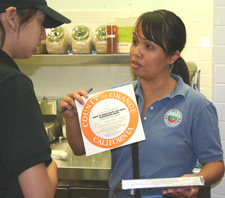 The inspector also provides the operator with informational bulletins, brochures, or other printed materials to advise them on food safety. Finally, an inspection notification seal is posted indicating that either the facility is in compliance or a follow-up inspection is scheduled for a later date.
The inspector also provides the operator with informational bulletins, brochures, or other printed materials to advise them on food safety. Finally, an inspection notification seal is posted indicating that either the facility is in compliance or a follow-up inspection is scheduled for a later date.
*Actual inspections may not follow this exact outline depending on the facility.